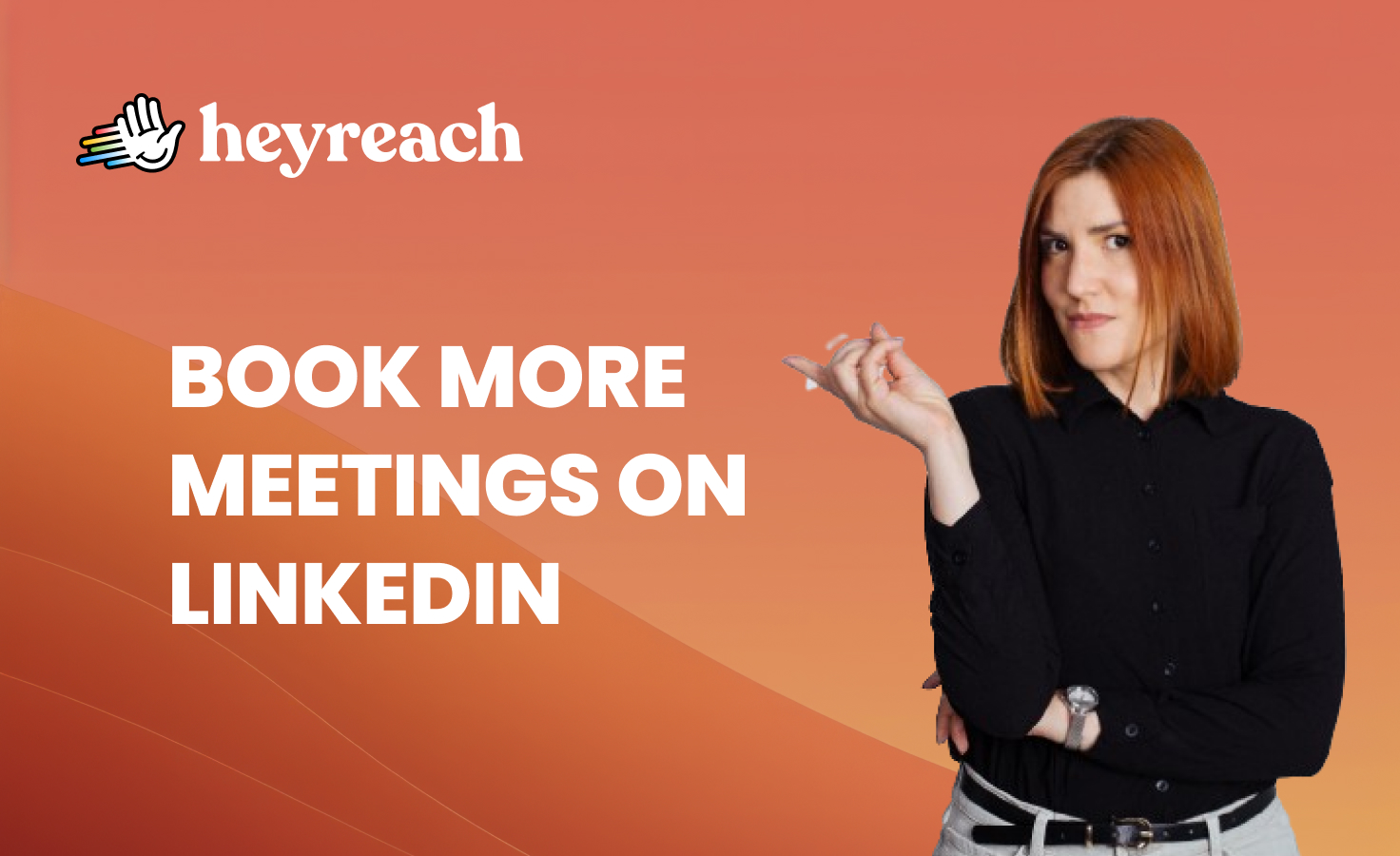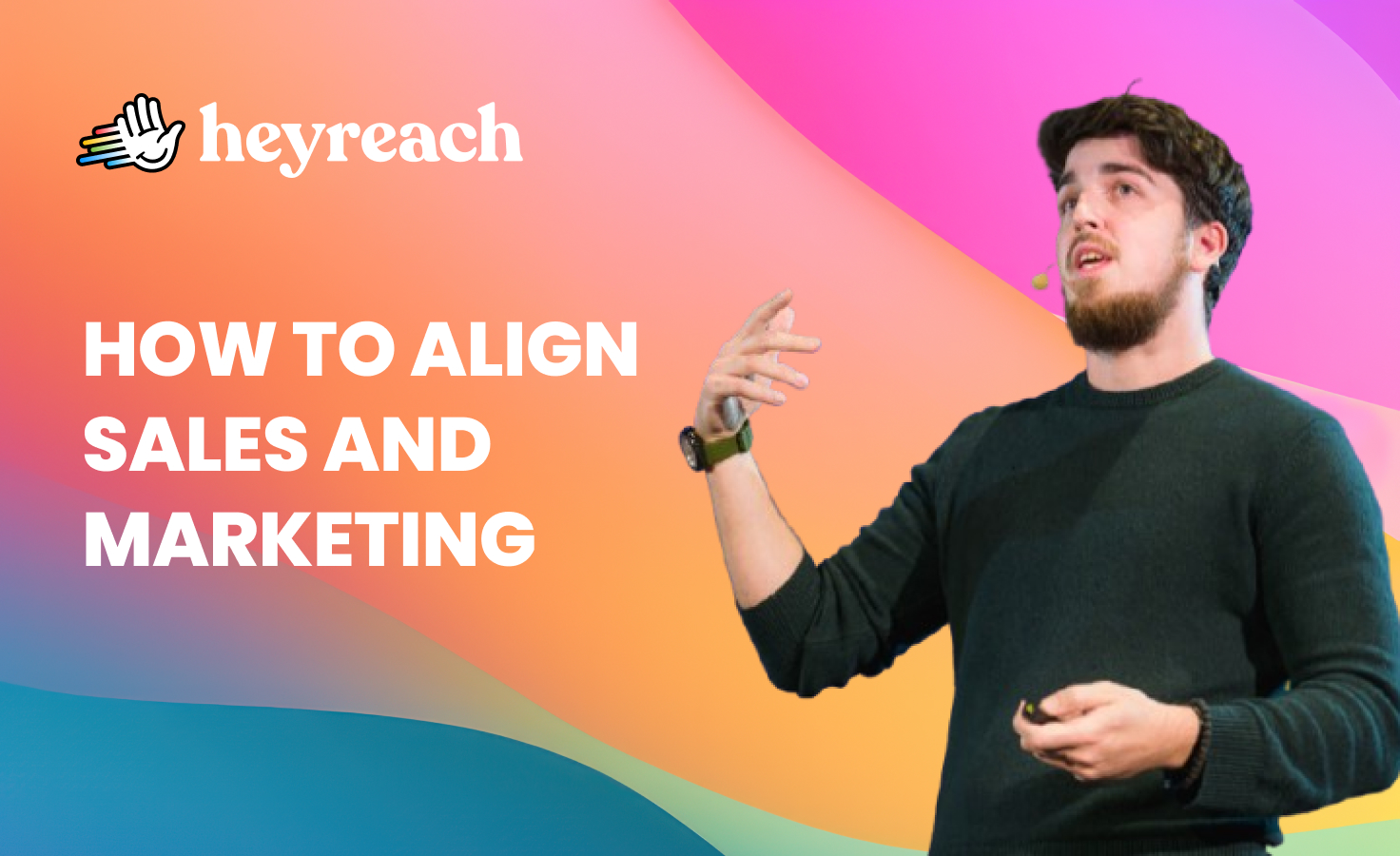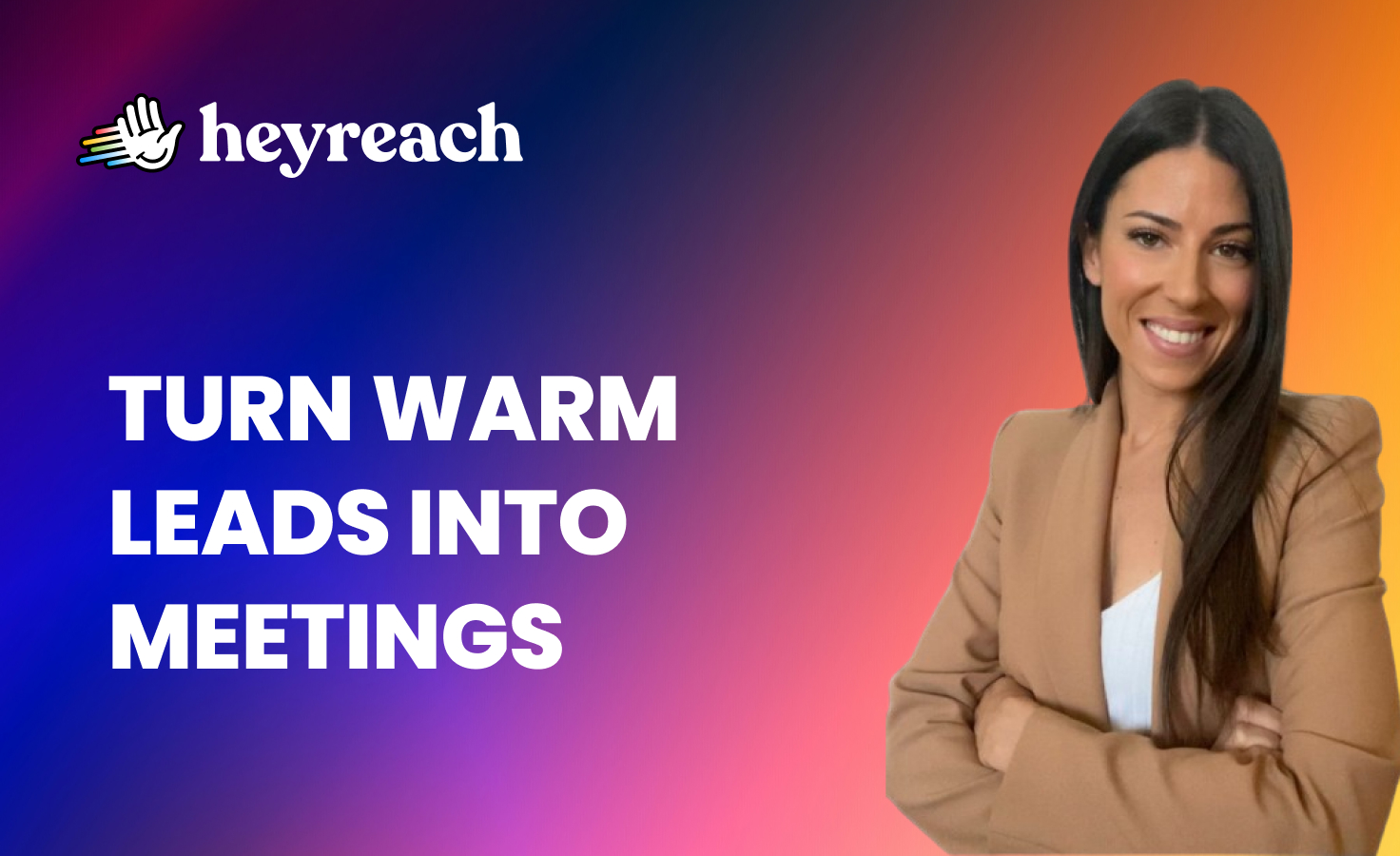Inbound leads are easier to convert than outbound leads. At least that’s the theory. Such leads have shown interest, have probably engaged with your content on social media or your website, and are maybe even familiar with your solution.
But as a BDR, you know it’s not that simple.
Some prospects are only browsing. Others will ghost you the moment you follow up. Many of them aren’t even the actual decision-makers. And let’s not even open the can of worms that is scaling inbound LinkedIn outreach.
Not all leads are at the same stage. Some are window shopping, others are comparing options. Only a few are truly ready to buy. That they’ve engaged and shown interest is a great start, but it’s still not a win. Competitors can still snatch up your leads, or they might lose interest and ignore your follow-ups.
This is why it’s crucial to have a structured outreach strategy. You’ve already done the prospecting and qualifying parts, so let’s talk about the third part of the lead gen flow - optimizing your inbound outreach efforts and moving leads through the pipeline effectively.
The need for speed: why first-touch response time matters
Inbound leads get cold faster than a plate of fried chicken left sitting on the table. If you don’t respond quickly, the lead is gone.
That’s why you need to have a structured engagement cadence that allows fast and personalized outreach.
And it all starts with a timely and personalized first-touch message.
Send a personalized LinkedIn connection request with a short message 5-10 minutes after they check out your post, resource, or product.
Head of Sales at HeyReach, Nadja Komnenic, has a simple 3-part LinkedIn outreach cadence that gets her 39% reply rate:
1. Initial DM
2. Follow-up (2 days later)
3. Final nudge (7 days later)
That’s really all you need.
You’re not making a sale here (although so many on LinkedIn try, bless them), but this first touch is vital for the entire conversation to keep going.
For example, send your qualified lead a message like this:
“Hey [Name], I saw you checked out our [product/solution], we’re happy to answer any questions you have about it! Are you available for a quick chat later this week?”
And if you want to maximize efficiency (of course you do), you have to double down on leads that show strong interest, the ones visiting your product or sales pages, engaging with your posts (with more than “Great Insigh!t”), or downloading your resources like webinars and ebooks. This is where tools like HeyReach can help you identify and prioritize high-intent leads.
All of this will help you keep the ball rolling, but still leave the room open for the lead to say “No thanks, I’m good.”
Balancing personalization & volume at scale
Personalizing your outreach messages will get you a reply much more likely than sending everyone the same generic message. But that often means a lot of manual work, and this scales badly.
Today, many inexperienced SDRs and BDRs fall into the trap of using ChatGPT or some other AI to write their messages, which shows a mile away.
That’s a recipe to get rejected or ghosted immediately.
Still, does that mean the only solution is to get extremely fast at typing outreach messages? No. Instead of fully relying on automation and completely losing the human touch in the process, use semi-automated personalization frameworks that will keep your outreach fast, but still human. Hunter found out that 67% of decision makers don't mind AI emails as long as they are relevant and personalized properly.
For example, here are some actionable tactics you should use:
Use the 80/20 personalization rule.
You don’t need to customize the entire message every time you want to engage a new lead. Instead, just customize one or two key elements, like their name and pain point, and keep the rest templated.
For example, you can use this message template:
“Hey [Name]. I noticed your team is scaling [Function]. Our team recently helped [Similar Company] with [Same Problem/Pain Point]. Are you up for a quick call?”
Use AI to create diverse message variations.
The reason every AI message sounds the same is that most people give it the same, basic prompt. But by using AI to craft different message variations, you’ll be less likely to trigger spam and will make your message sound more authentic.
As Trevor Young, CPO at Security Compass, says:
“AI in outreach, useful but not a magic bullet. AI is great for drafting messages, analyzing response rates, and testing different approaches. But it can’t replace real human connection. The best outreach strategies use AI to help with volume and structure, then let real people step in once a conversation starts.”
Here is how you SHOULDN’T reach out to someone on LinkedIn:

It’s not even all the spelling errors.
⚠️ It doesn’t mention my name (instead, I got a generic “Dear Sir” , while I’m obviously a ma’am).
⚠️ It’s crystal clear they did zero research on what my pain points might be – they talk awfully a lot about themselves though.
⚠️ Also, the non-existent Alexa rank took me off. For my non SEO people - it’s Ahrefs, not Alex.
It just screams spam, and craves >delete and report<.
💡For detailed guide and examples that worked for my colleague Ilija, CRO at HeyReach, jump straight to How to Reach Out to Someone on LinkedIn [11 Tactics].
Use HeyReach’s multi-account rotation and unibox features
Let’s say there’s six of you in the team (like us on the image down under), and you need to reach thousands of leads that are already in your funnel, without violating LinkedIn's limits (25 connections, 40 messages, and 100 InMails). The best way to do this would be to include all available senders into one campaign and they’ll autorotate and contact different people from the given list.
You'll easily find LinkedIn Accounts tab on the left side of the HeyReach dashboard (second icon from above - conveniently the LinkedIn logo). From there you can add you're team member accounts, and configure their daily limits (although, we strongly recommend you don't go above the pre-set ones).

You can connect all types of LinkedIn accounts (called “senders” inHeyReach) to increase your daily sending volume per campaign by clicking the “connect account” button on the top right.
This will give you two options.
- Infinite login that combines LinkedIn credentials and 2FA.
- Log in with your LinkedIn account credentials (username and password)

We recommend the first option - Infinite login, since it will keep your account always connected. However, you need to have 2FA enabled on LinkedIn to use this option.

Once you have your 2FA secret key, click the “next” button at the bottom and enter your LinkedIn email address and password, your 2FA key, and finally your LinkedIn account.

Automating and optimizing engagement cadences
Inbound leads don’t stay fresh for long. Many take their sweet time to reply, some you never get a response back from, and others get lost somewhere in the pipeline. It’s just impossible to keep track of dozens, let alone hundreds of leads manually.
The solution is to automate your LinkedIn cadence. But do it thoughtfully. That means not doing stuff like this:
- Sending mass, generic, no-context, and no-personalization connection requests.
- Going straight for the pitch after they accept your request.
- Sending zero-value, bot-driven comments on their posts and calling it “engagement”.
- Trying to hard-sell despite no engagement from them.
- Sending them a LinkedIn video or voice note out of nowhere.
- Guilt-tripping leads to not responding.
- Tagging random prospects in public posts to get attention.
Not only will these lead to potential customers ignoring your call to action, but they will also block you. Not to mention that you’ll end up on several “Petty spammer” lists, probably.
Instead, create and automate a LinkedIn cadence that will keep you on top of their minds, just ensure you avoid being pushy or annoying.
This exact LinkedIn outreach strategy helped Nadja from HeyReach get over 65% reply rate and helped generate her and her clients over $4,000,000 in revenue.
Example of a well-optimized and automated LinkedIn cadence that leads to building relationships
Day 1: Send a personalized connection request with contextual value
“Hey [First Name]. I noticed we both follow [Shared Connection]. I’d love to connect and share insights on [Mutual Topic]!
Day 3: Like or comment on their recent post to spark conversation
“Hey [First Name]. I saw your post on [Topic]. Interesting take. Any thoughts on [Related Topic]?”
Day 5: Send a targeted value-add message based on the lead’s behavior
“Hey [First Name]. I came across this [Resource] on [Topic]. I’d love to hear your thoughts on [Related Topic].”
Day 8: Go multichannel and engage with the lead’s recent non-LinkedIn activity
Here’s an 8-step, multichannel approach Gunner Park from Brij uses to engage outbound leads:
Day 10: Send a LinkedIn voice note or video message
Save this one for high-value leads that have shown clear interest (i.e., they’ve engaged). If you’re using HeyReach, you can send a voice note via both the LinkedIn mobile app and desktop (normally, this is possible only via the mobile app). Additionally, you can use video templates that you can mix and match with prepared outreach for higher level of personalization.
You can also send a quick message to accompany the voice note.
“Hey [First Name]. I wanted to send you a quick voice note to connect on a more personal level, since I see you’ve been exploring [Topic] and I’ve been working on [Similar Challenge].”
Day 15: Use CRM-triggered follow-ups based on the lead's behavior
If a prospect re-engages (i.e., visits the website again), you can use CRM triggers to restart the outreach.
“Hey [First Name]. I saw you check our [Page/Product/Podcast] recently. I wanted to reach out to see if you had any questions or if there’s anything more you’d like to explore. I’d be happy to chat and answer your questions!”
Day 20: Soft close or break-up message
If the prospect has still not engaged, it’s time to say thank you and politely leave, but leave the door open.
“Hey [First Name]. I realize this might not be the best time for a conversation. If things change or you become interested down the line, please don’t hesitate to reach out. (Here is my contact information.) Here’s to your continued success!”
Re-engaging unresponsive inbound leads
Many inbound leads engage on social media platforms like LinkedIn, but won’t convert right away, so they may need some re-engagement along the way.
Create a re-engagement campaign using HeyReach automation and LinkedIn. Here’s how Ilija Stojkovski, CRO at HeyReach, created a 5-step campaign to re-engage lost leads and got a 67% reply rate.
He sent 42 connections, got 24 accepted (57.5%), all 24 accepted messages, and finally 16 (66.7% replied).
You can use the ecaxt same steps that lead to 66,7% reply rate for HeyReach's internal team
Step 1: Create message templates
Using Fireflies AI notetaker, integrated into HeyReach’s HubSpot stack and linked with Slack, X, and other apps, he could capture transcripts from voice conversations, calls, and meetings anytime, anywhere with high accuracy and share with his team.
Step 2: Separating lost leads from other categories
Segmenting your audience is vital in any sales or marketing strategy. You can segment based on demographics, geography, psychographics, behavior, technology use, etc. Without it, outreach is like turning your back on your audience and throwing a ball, hoping to hit someone in particular. That’s just not going to happen.
Step 3: Send an automated LinkedIn connection request
Once he segmented his leads, Ilija ended up with 42 inbound leads to whom he sent an automated, but contextual message:
“Hey [Name], not sure if you remember meeting, but we spoke a couple of months ago about using HeyReach for LinkedIn automation and outreach strategies [Company]. How are things on the LinkedIn front?”
Step 4: Send automated follow-up messages
The connection request got a 57.5% acceptance rate (24 of 42) and was followed by a more casual message:
“BTW, I maaaayyyy have created an integration tool that took our call transcript from Fireflies and our Clay to write our last message. Wanna see how?”
This message got 16 replies.
Step 5: Assessing the results
Finally, a 67% reply rate and 57.5% accepted connections. Not too shabby.
Scaling without getting banned: LinkedIn outreach best practices
LinkedIn as a lead generation channel has become much more relevant for SDRs and BDRs in the last 2-3 years and threatens to overtake other channels, like direct mail and email, especially due to a higher response rate and real-time targeting.
Of course, email still has its advantages, like often more automation options, lower deployment cost, or rich formatting, but it has something else that people hate.
Spam.
Years and years of bad salesy emails have created an automatic spam trigger in a lot of people, making it difficult for even good sales teams to get potential customers to move past the subject line.
So a lot of them turned to LinkedIn for outreach.
But that’s not because LinkedIn tolerates spam.
Quite the contrary, LinkedIn has zero tolerance toward spam and if you start outreaching the wrong way, you get a one-way ticket to ban-city.
Instead, follow these LinkedIn best practices to maximize your outreach without penalties:
- Optimize your LI profile for inbound. Most people fail to optimize their LinkedIn profiles and wonder why it doesn’t work. If you’re going to use it for inbound engagement, you need stuff like a professional photo, an industry-aligned banner, a good headline, summary, etc..
- Stay under LinkedIn’s connection limits. LinkedIn allows 100-200 requests per week, depending on the user’s SSI (Social Selling Index) and engagement level. Although there’s no daily limit, it’s best to stay around 15-25 to keep within the weekly limit.
- Don’t be a spammer; use different message variations. For example, you can use the prospect’s name, company, industry, or recent activity to personalize the message, rotate message types (text message, voice notes, video message), use CRM tools to randomize messages, and more. Send messages strategically. Reference shared interests, mutual connections, or relevant insights from their profile or posts.
- Use secure automation tools. Not all tools are created equal. Some are more secure than others. There’s also different perks, features, and pricing tiers. However, make sure you choose those operating under the LinkedIn limits and Terms of Service.
- Use VPN when you're working on public places. You're putting in risk a lot of sensitive business information by opening ton of apps in random caffee. Also , your team handles sensitive lead information, so consider pairing them with a business VPN to ensure data privacy and compliance.
- First, engage, then message. Cold outreach rarely works. If you try sliding into someone’s DM without a prior relationship to pitch your product/service, expect a “no” 9 out of 10 times.
- Share valuable content with the leads. This doesn’t have to be your content, but preferably it should be. Ideally, you can make a mix of the content you curate, and the content you read/watched and found valuable and reasoning with your audience. These can be posts, case studies, webinars, industry insights, something you read in a forum, etc. Just make sure to give proper credit, don’t do the rip offs. Be mindful of your online security as your profile grows. Using an identity theft protection service can help monitor and alert you if your personal information is misused or if suspicious activity related to your professional identity is detected, helping you safeguard your reputation and data.
A great example of sharing done right is Gaetano's post sharing insights from Kevin’s newsletter.

- Respect a “no.” A “no” can come in many forms. It can be a hard “no”, or they might not respond. If there’s no reply after two follow-ups, don’t push it.
The future of inbound outreach on LinkedIn
Scaling inbound outreach on LinkedIn is a challenge in itself. On one hand, it’s impossible to give your full attention to every lead (personalization), but on the other, automating everything just makes you sound like a bot.
The answer lies in balancing automation and personalization. That way, you ensure you reach a wide audience and not lose the human touch necessary for engagement. If you don’t have the right sales outreach strategy, this leads to low-quality leads, ghosting, and burnout.
These obstacles are not insurmountable. You can overcome them. Just remember to implement these key takeaways in your next LinkedIn inbound outreach campaign:
- Speed matters. Engage while the lead is still hot. Your first-touch must not only be timely, but also effective to keep them warmed up and ready to respond.
- Balance personalization and automation. You can’t hope to maximize outreach if you rely on one while ignoring the other. Instead, use a semi-automated framework that will allow you to scale and maintain a human touch.
- Use success stories. While the statistics for LinkedIn on this matter are limited, having success stories has been shown to boost response rates by 45% in email marketing campaigns.
- Follow-up thoughtfully. Following up isn’t a matter of randomly sending messages to leads. Your cadence must be well-thought-out and optimized based on lead engagement level and intent.
- Be mindful of LinkedIn’s restrictions and ToS. Don’t get overzealous. You won’t help your inbound outreach campaign, potential customers, or anyone else if you get flagged for spam or exceed your connection limit. That can only lead to LinkedIn jail.
Always keep refining your outreach strategy through testing and iteration. Start implementing these tactics in your LinkedIn campaigns, track your results, and fine-tune them based on what works best for you.
Not sure where to start? Schedule a 1-on-1 strategic call, and we’ll help you make an effective outreach strategy and improve conversion rates.








.webp)